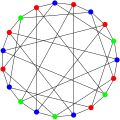| Robertson graph | |
|---|---|
 The Robertson graph is Hamiltonian. | |
| Named after | Neil Robertson |
| Vertices | 19 |
| Edges | 38 |
| Radius | 3 |
| Diameter | 3 |
| Girth | 5 |
| Automorphisms | 24 (D12) |
| Chromatic number | 3 |
| Chromatic index | 5 [1] |
| Book thickness | 3 |
| Queue number | 2 |
| Properties | Cage Hamiltonian |
| Table of graphs and parameters | |
In the mathematical field of graph theory, the Robertson graph or (4,5)-cage, is a 4-regular undirected graph with 19 vertices and 38 edges named after Neil Robertson. [2] [3]
Contents
The Robertson graph is the unique (4,5)-cage graph and was discovered by Robertson in 1964. [4] As a cage graph, it is the smallest 4-regular graph with girth 5.
It has chromatic number 3, chromatic index 5, diameter 3, radius 3 and is both 4-vertex-connected and 4-edge-connected. It has book thickness 3 and queue number 2. [5]
The Robertson graph is also a Hamiltonian graph which possesses 5,376 distinct directed Hamiltonian cycles.
The Robertson graph is one of the smallest graphs with cop number 4. [6]




